Influence of Cross-Wind on CO2 Arc Welding of Carbon Steel
Abstract
:1. Introduction
2. Experimental Method
2.1. Common Experimental Condition
2.2. Shadowgraph Observation
2.3. Nitrogen Fraction Measurement
3. Simulation Model
4. Results and Discussion
4.1. Shadowgraph Observation
4.2. Nitrogen Fraction Measurement
4.3. Numerical Simulation
5. Conclusions
- The result of the shadowgraph observation presented that the smaller nozzle diameter and the larger gas flow rate prevented the bending of the shielding gas flow.
- The result of nitrogen fraction measurement showed that the smaller nozzle diameter and the larger gas flow rate decreased the nitrogen fraction. Not noticeable, the amount of nitrogen tended to decrease slightly, with the decrease in nozzle length the increase of orifice number and orifice diameter. Then, the result of the nozzle diameter and the gas flow rate agreed with the bending tendency of the shielding gas flow seen in the shadowgraph observation.
- The result of the CFD simulation showed that when the nozzle diameter decreased or the gas flow rate increased, the vertical gas flow velocity at the nozzle exit clearly increased. The nozzle length, the orifice number, and the orifice diameter were found to hardly affect the vertical gas flow velocity.
- The main factor that governs wind resistance is the gas flow velocity in the vertical direction at the nozzle exit. The nitrogen fraction is found to be decreased by increasing the averaged vertical gas velocity. The nitrogen fraction was largely decreased when the averaged vertical gas flow velocity exceeded the cross-wind velocity of 5 m/s. A sufficient decrease in nitrogen fraction was obtained if the averaged vertical gas flow velocity became more than 150% of the cross-wind velocity. For achieving this, it is especially effective to decrease the nozzle diameter or increase the gas flow rate.
Author Contributions
Funding
Institutional Review Board Statement
Informed Consent Statement
Data Availability Statement
Conflicts of Interest
References
- Jeffus, L. Welding: Principles and Application, 7th ed.; Delmar Publications: Clifton Park, NY, USA, 2012; pp. 55–157. [Google Scholar]
- Murphy, A.B. A Perspective on Arc Welding Research: The Importance of the Arc, Unresolved Questions and Future Directions. Plasma Chem. Plasma Process. 2015, 35, 471–489. [Google Scholar] [CrossRef]
- Oliveira, J.P.; Crispim, B.; Zeng, Z.; Omori, T.; Fernandes, F.M.B.; Miranda, R.M. Microstructure and mechanical properties of gas tungsten arc welded Cu-Al-Mn shape memory alloy rods. J. Mater. Process. Technol. 2019, 271, 93–100. [Google Scholar] [CrossRef]
- Oliveira, J.P.; Curado, T.M.; Zeng, Z.; Lopes, J.G.; Rossinyol, E.; Park, J.M.; Schell, N.; Fernandes, F.M.B.; Kime, H.S. Gas tungsten arc welding of as-rolled CrMnFeCoNi high entropy alloy. Mater. Des. 2020, 189, 108505. [Google Scholar] [CrossRef]
- Tanaka, M.; Lowke, J.J. Predictions of weld pool profiles using plasma physics. J. Phys. D Appl. Phys. 2007, 40, R1–R23. [Google Scholar] [CrossRef]
- Sugiura, K.; Kodama, S.; Tsujimura, Y.; Murphy, A.B.; Tanaka, M. Numerical modeling of nitrogen absorption during gas tungsten arc welding. Q. J. Jpn. Weld. Soc. 2013, 31, 14s–17s. [Google Scholar] [CrossRef] [Green Version]
- Tamaki, K.; Masumoto, I.; Takahashi, Y. Some observation of the gas shielding conditions of CO2 arc welding by the application of a television system. J. Jpn. Weld. Soc. 1978, 47, 37–42. [Google Scholar] [CrossRef]
- Dreher, M.; Füssel, U.; Rose, S.; Häßler, M.; Hertel, M.; Schnick, M. Methods and results concerning the shielding gas flow in GMAW. Weld. World 2013, 57, 391–410. [Google Scholar] [CrossRef]
- Suzuki, R.; Sasakura, S.; Yokota, Y.; Sato, T.; Shigemori, Y.; Uenaka, A.; Nishimura, H.; Kiso, H. Study of wind-toughness of metal arc welding with reference to multi-pass weld metal quality. Weld. Int. 2017, 31, 17–27. [Google Scholar] [CrossRef]
- Cai, C.; Li, L.; Tai, L. Narrow-gap laser-MIG hybrid welding of thick-section steel with different shielding gas nozzles. Int. J. Adv. Manuf. Technol. 2017, 92, 909–916. [Google Scholar] [CrossRef]
- Pei, H.; Liu, C.; Chen, Y.; Wang, G. Influence of nozzle structure on the consumption of shielding gas in the gas metal arc welding process. Int. J. Adv. Manuf. Technol. 2020, 106, 2843–2859. [Google Scholar] [CrossRef]
- Mamat, S.B.; Tashiro, S.; Tanaka, M.; Yusoff, M. Study on factors affecting the droplet temperature in plasma MIG welding process. J. Phys. D Appl. Phys. 2018, 51, 135206. [Google Scholar] [CrossRef]
- JIS G 1228-1997: Iron and steel-Methods for Determination of Nitrogen Content, Thermal Conductimetric Method after Fusion in a Current of Inert Gas (1). (In Japanese)
- Menter, F.R. Two-equation eddy-viscosity turbulence models for engineering applications. AIAA J. 2012, 32, 1598–1605. [Google Scholar] [CrossRef] [Green Version]
- Murphy, A.B.; Arundell, C.J. Transport coefficients of argon, nitrogen, oxygen, argon-nitrogen and argon-oxygen plasmas. Plasma Chem. Plasma Process. 1994, 14, 451–490. [Google Scholar] [CrossRef]
- Murphy, A.B. Transport coefficients of air, argon-air, nitrogen-air and oxygen-air plasmas. Plasma Chem. Plasma Process. 1995, 15, 279–307. [Google Scholar] [CrossRef]
- Murphy, A.B. The effect of metal vapour in arc welding. J. Phys. D Appl. Phys. 2010, 43, 434001. [Google Scholar] [CrossRef]
- Boulos, M.I.; Fauchais, P.; Pfender, E. Therm. Plasmas: Fundamentals and Applications; Springer: New York, NY, USA, 1994; pp. 4–5. [Google Scholar]
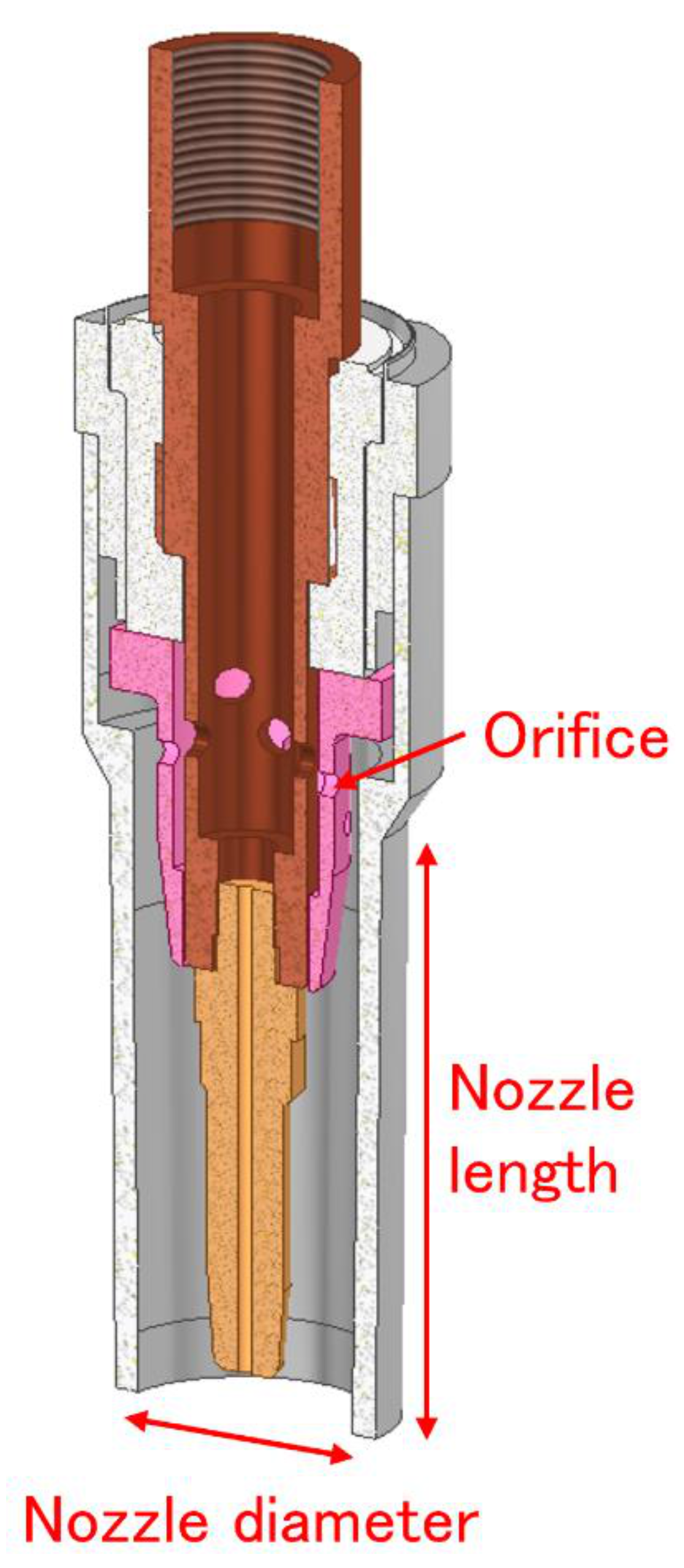
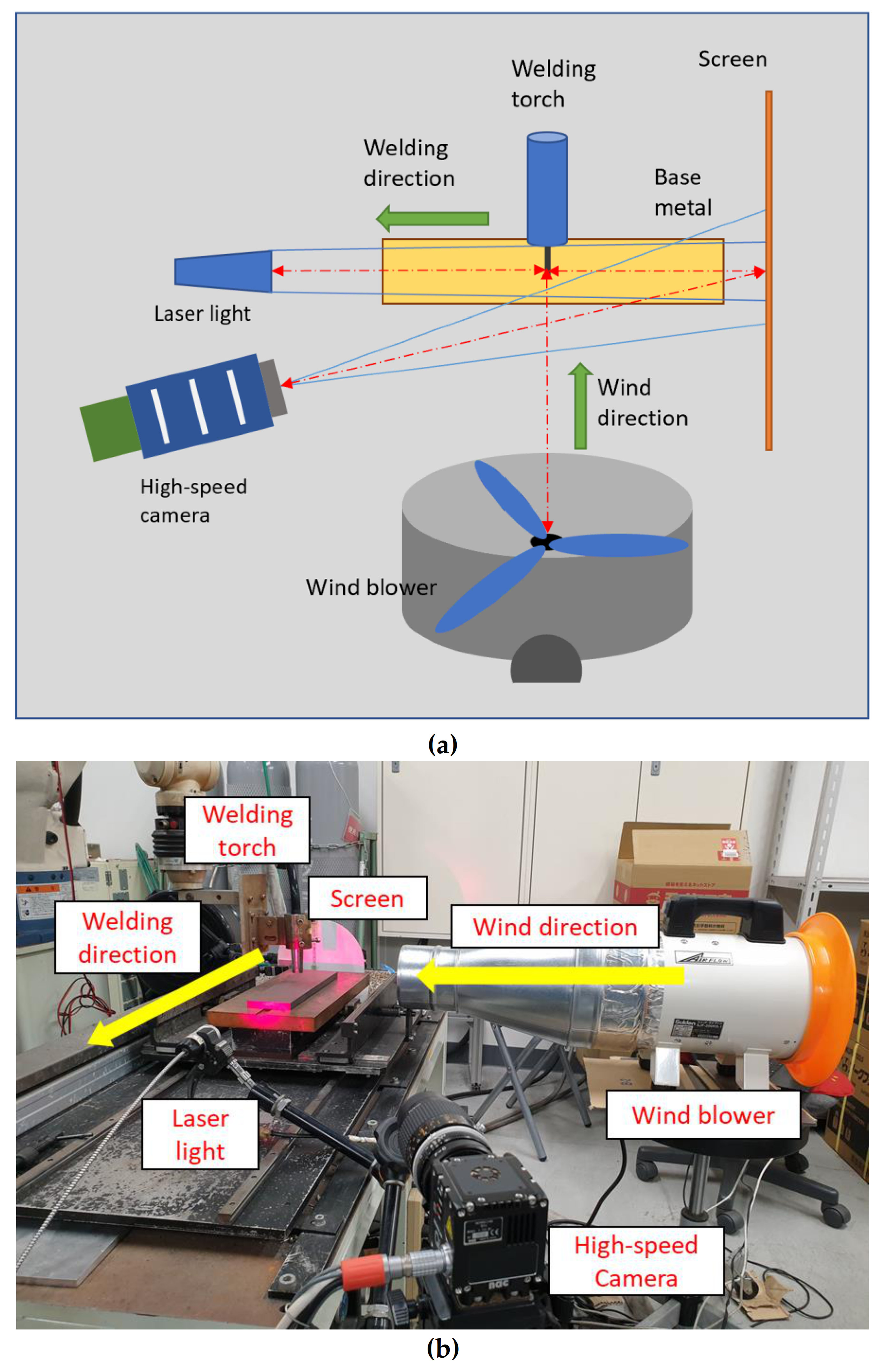

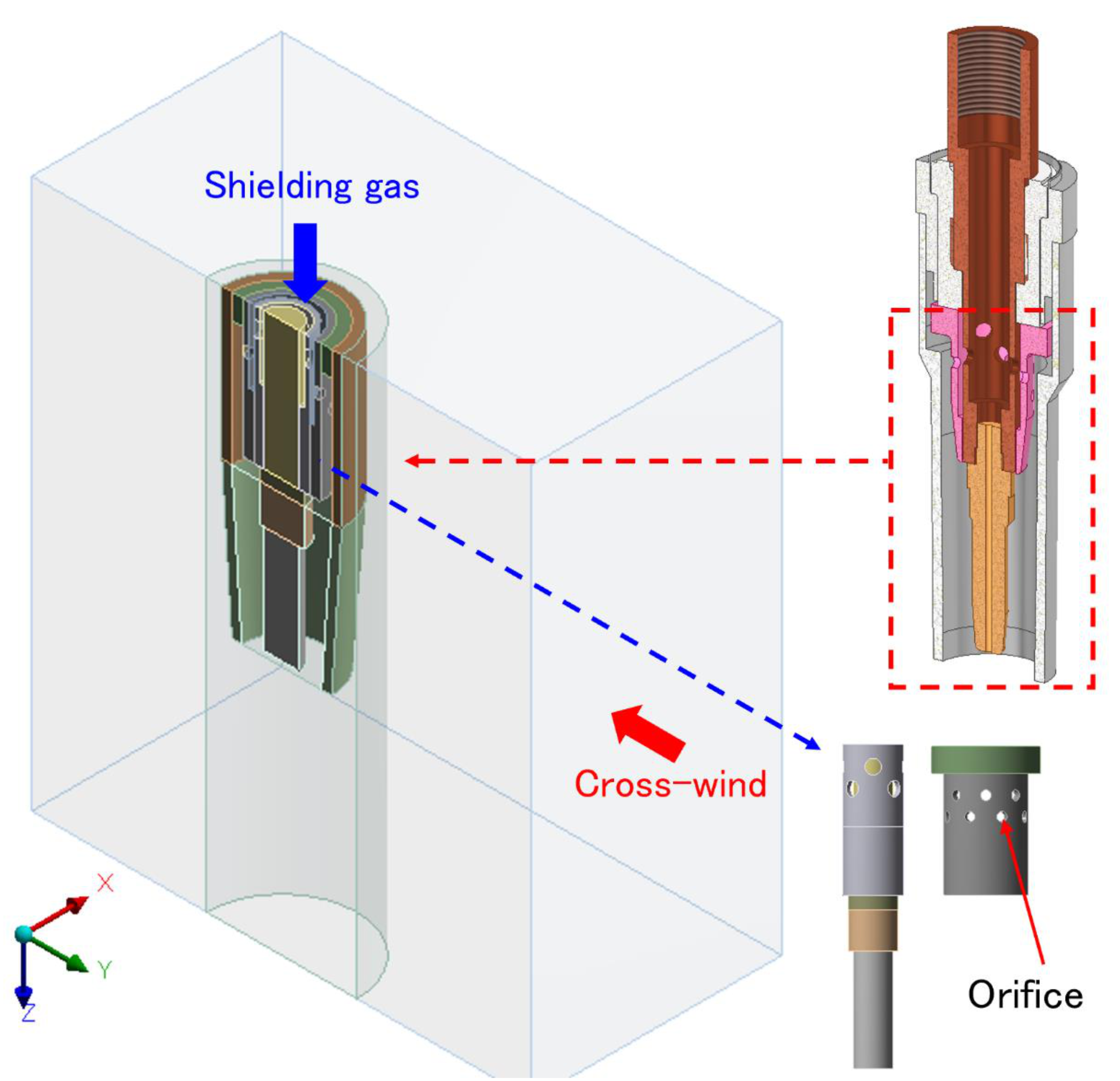
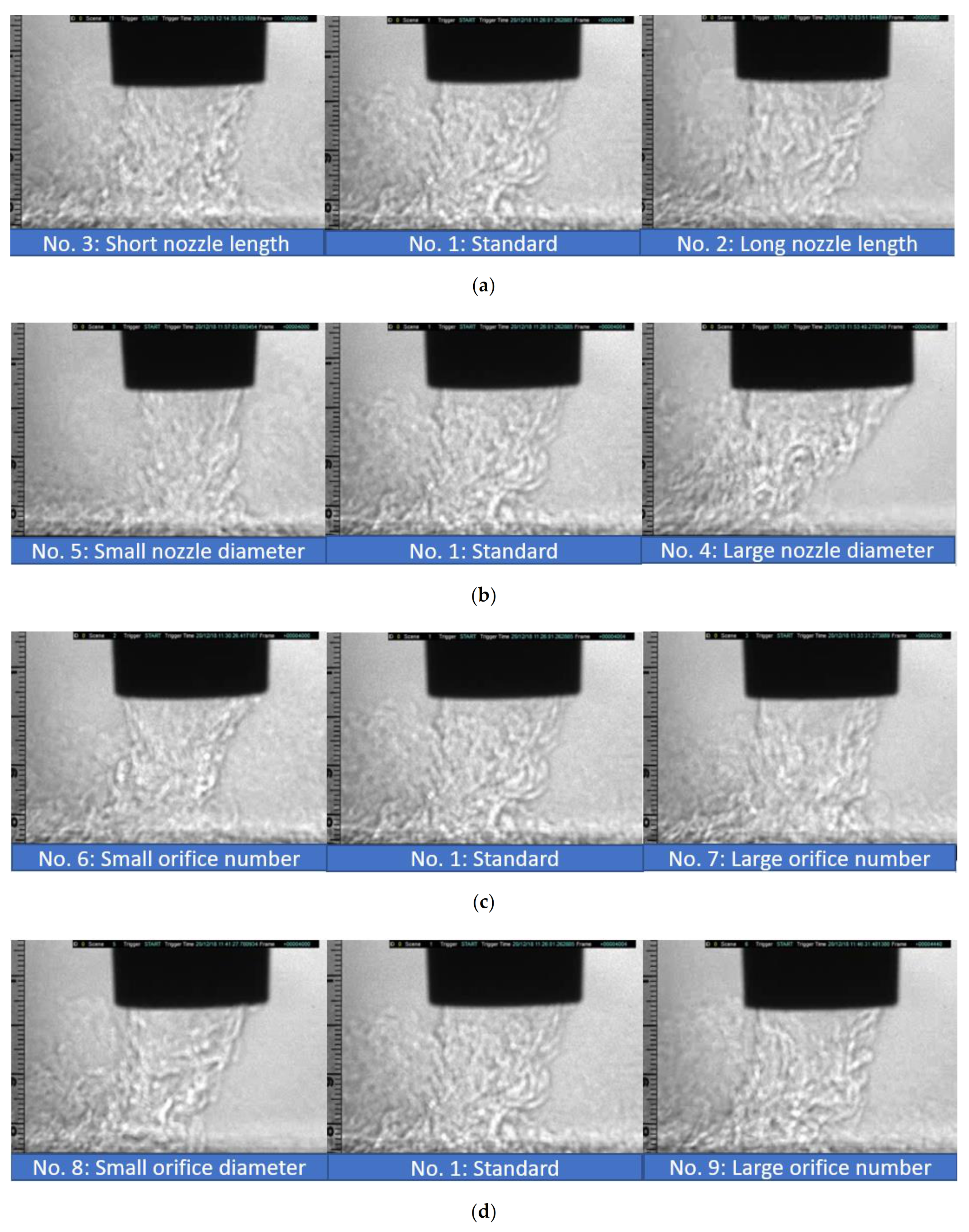

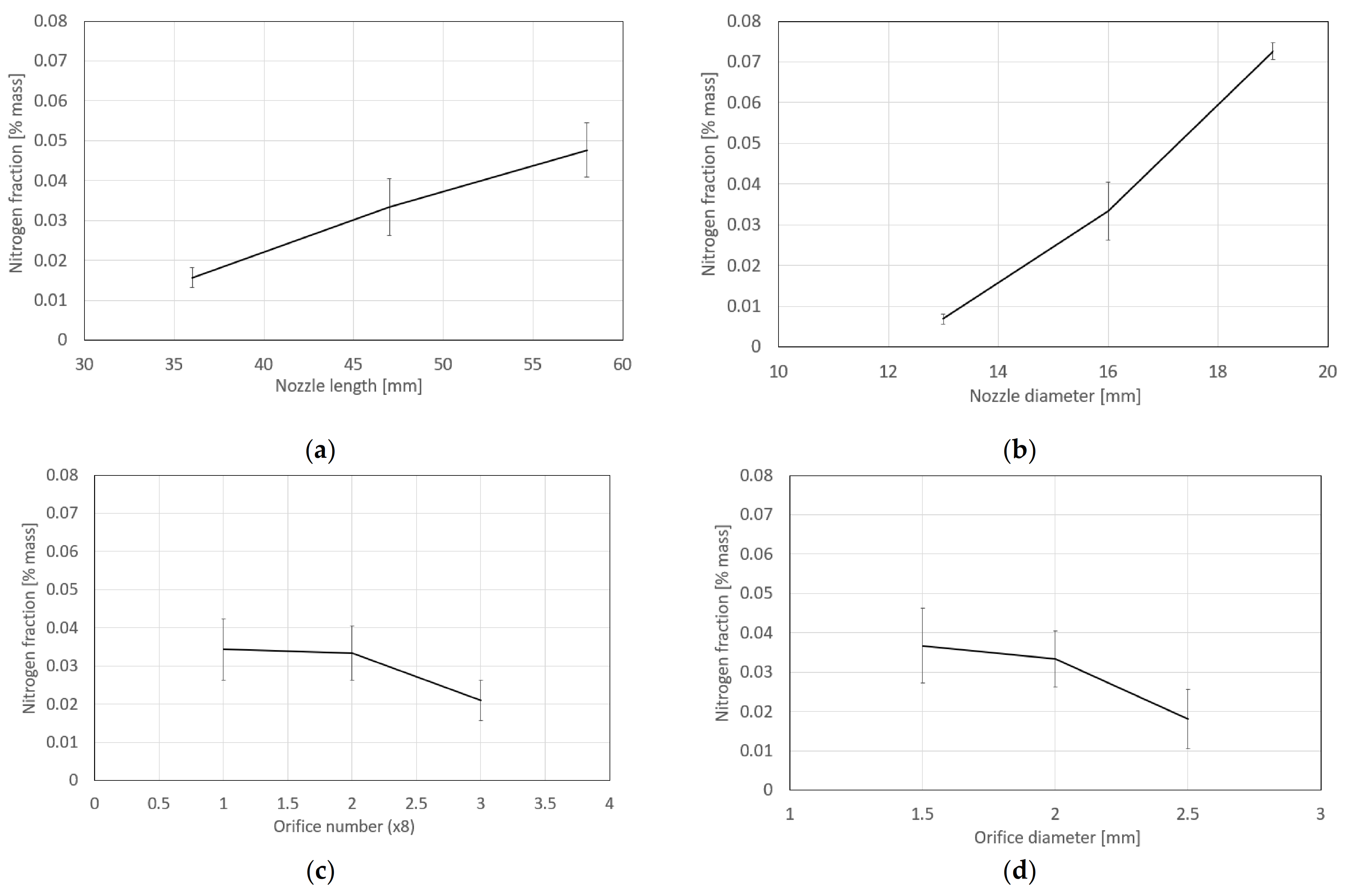
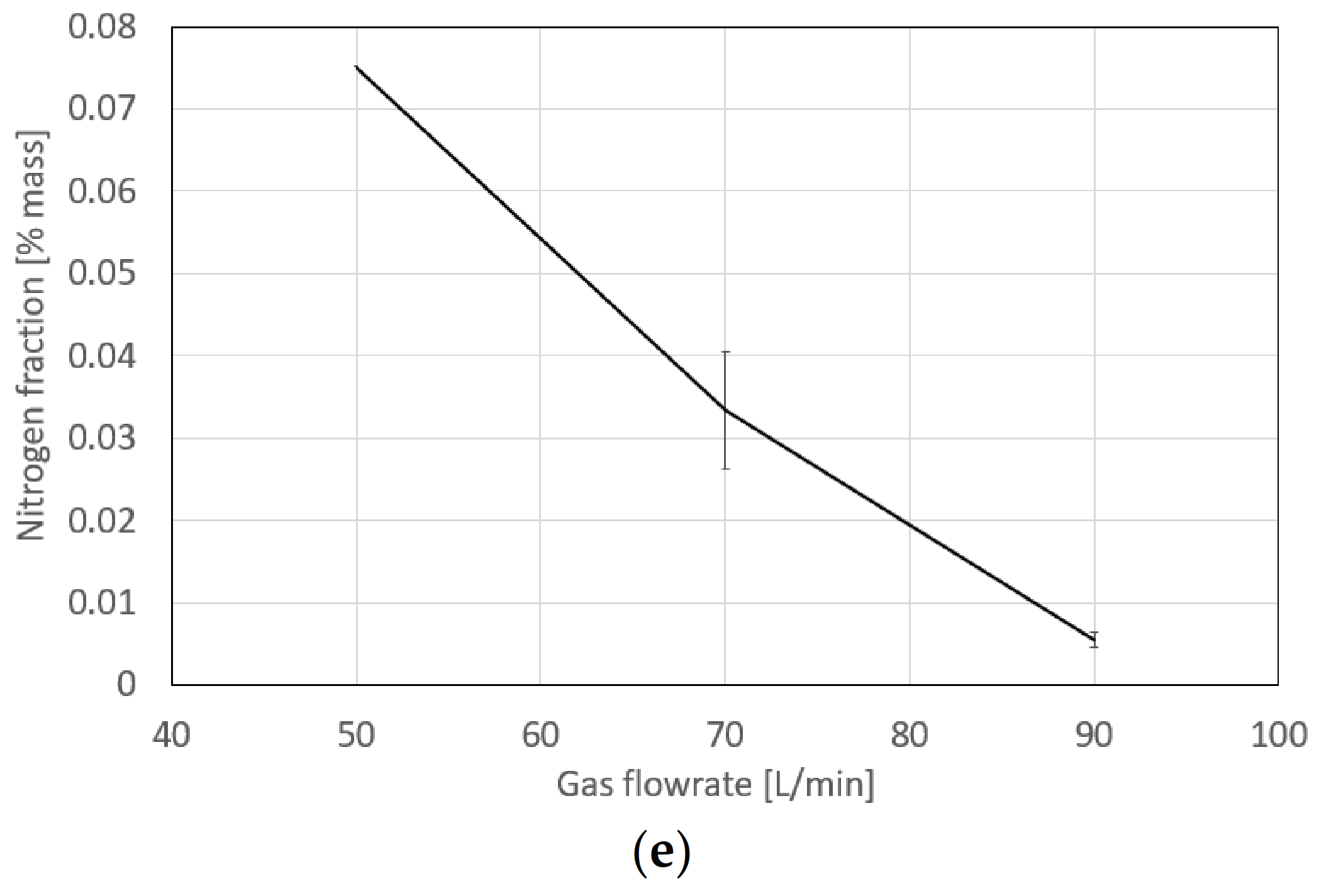
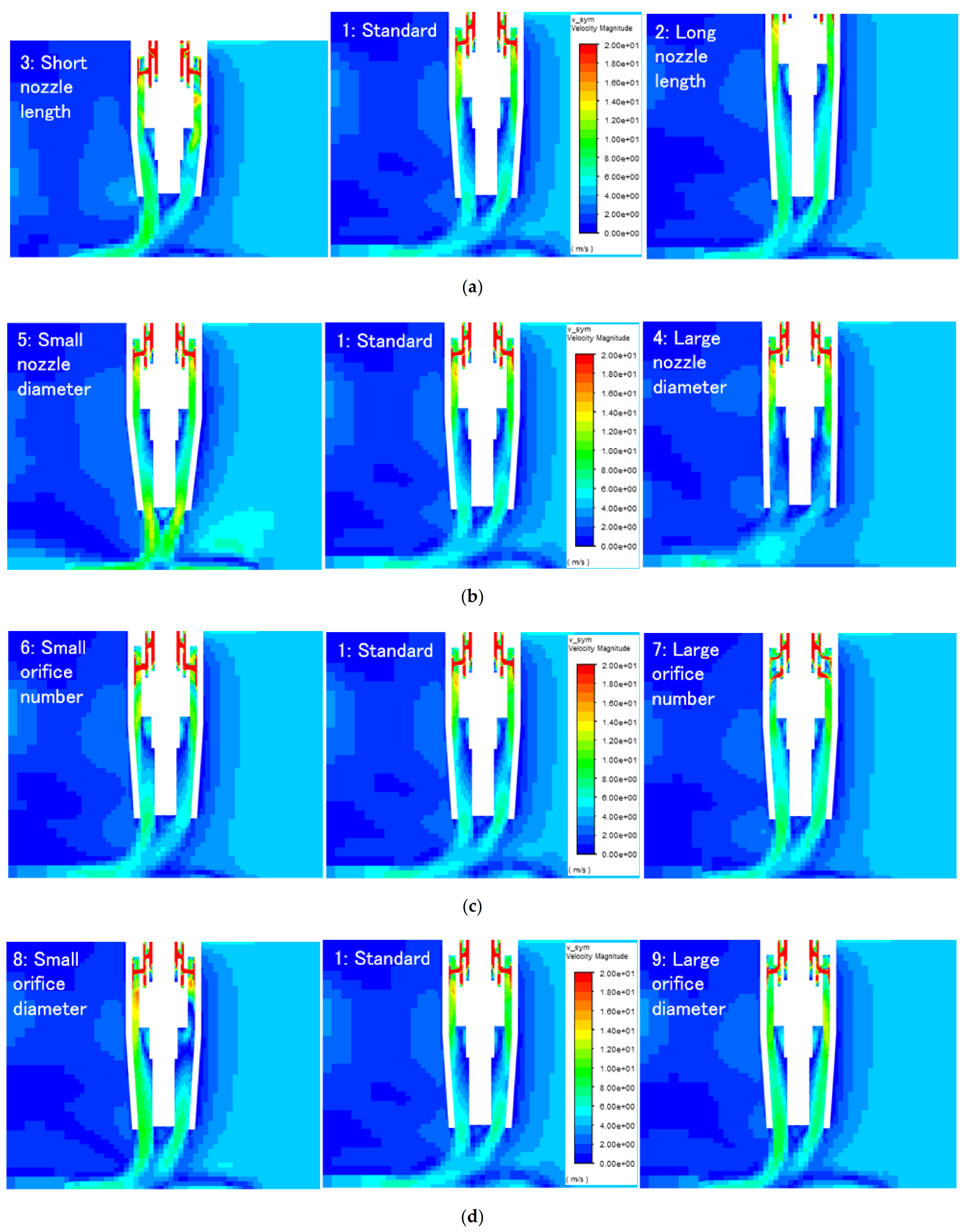

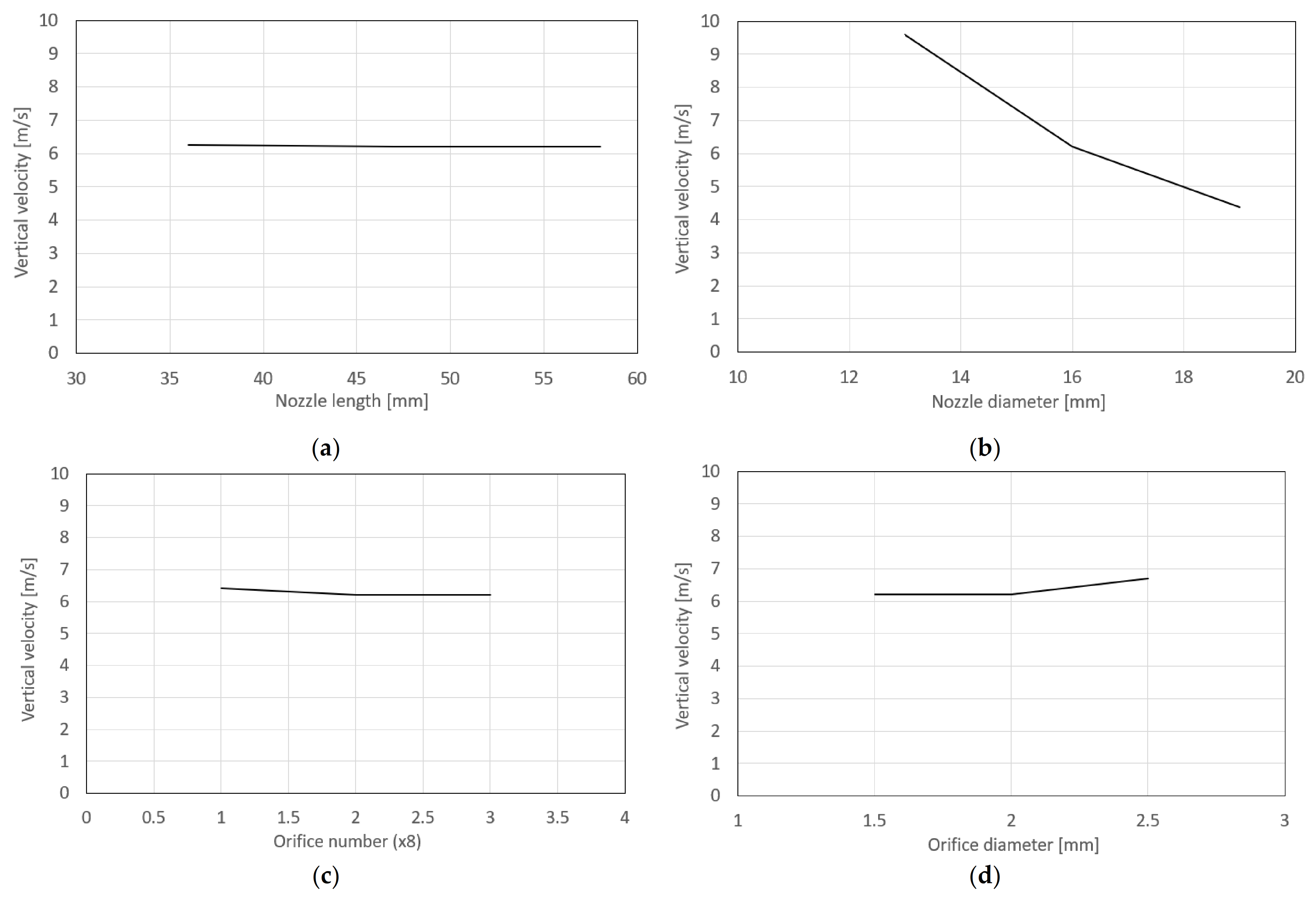
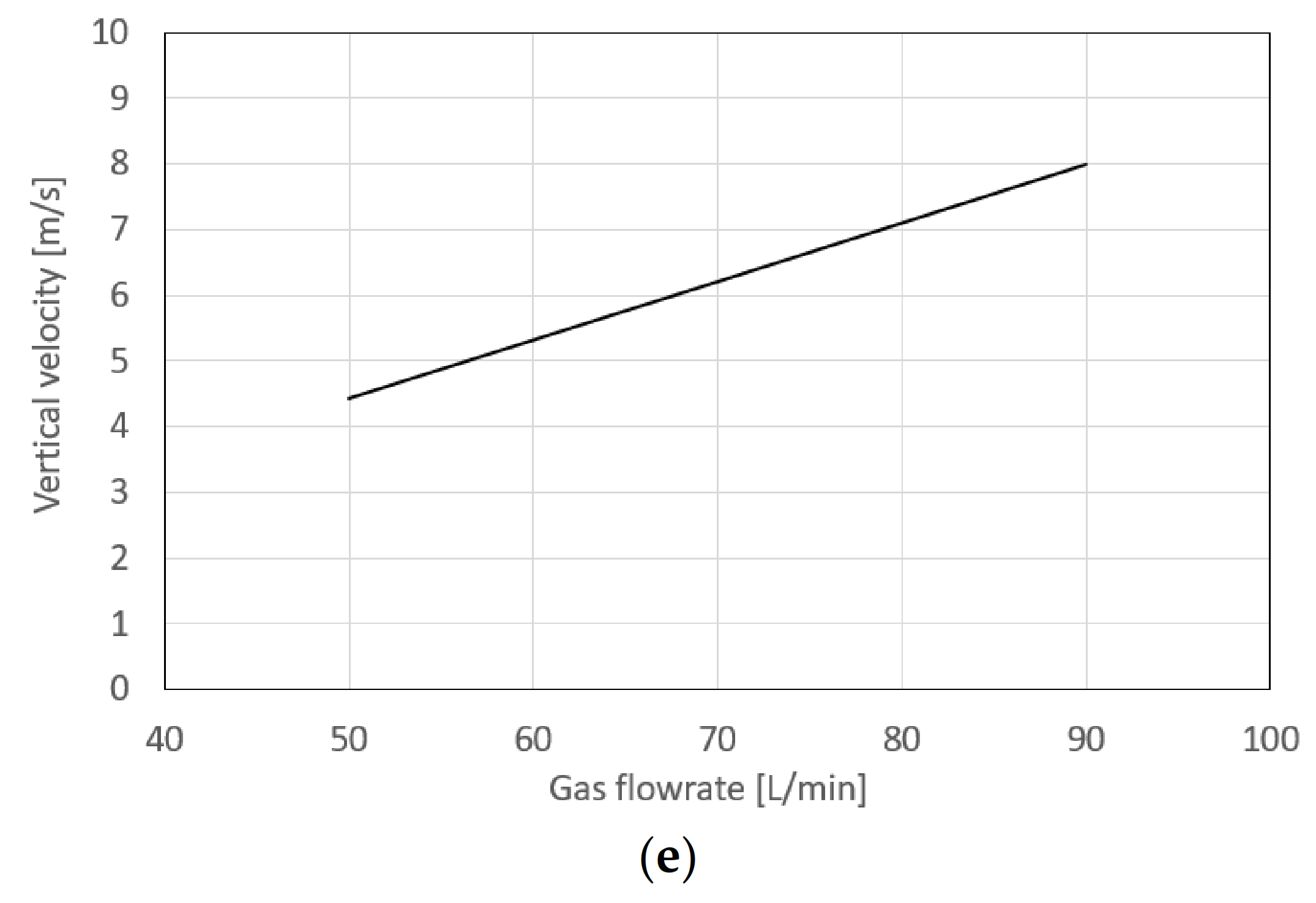
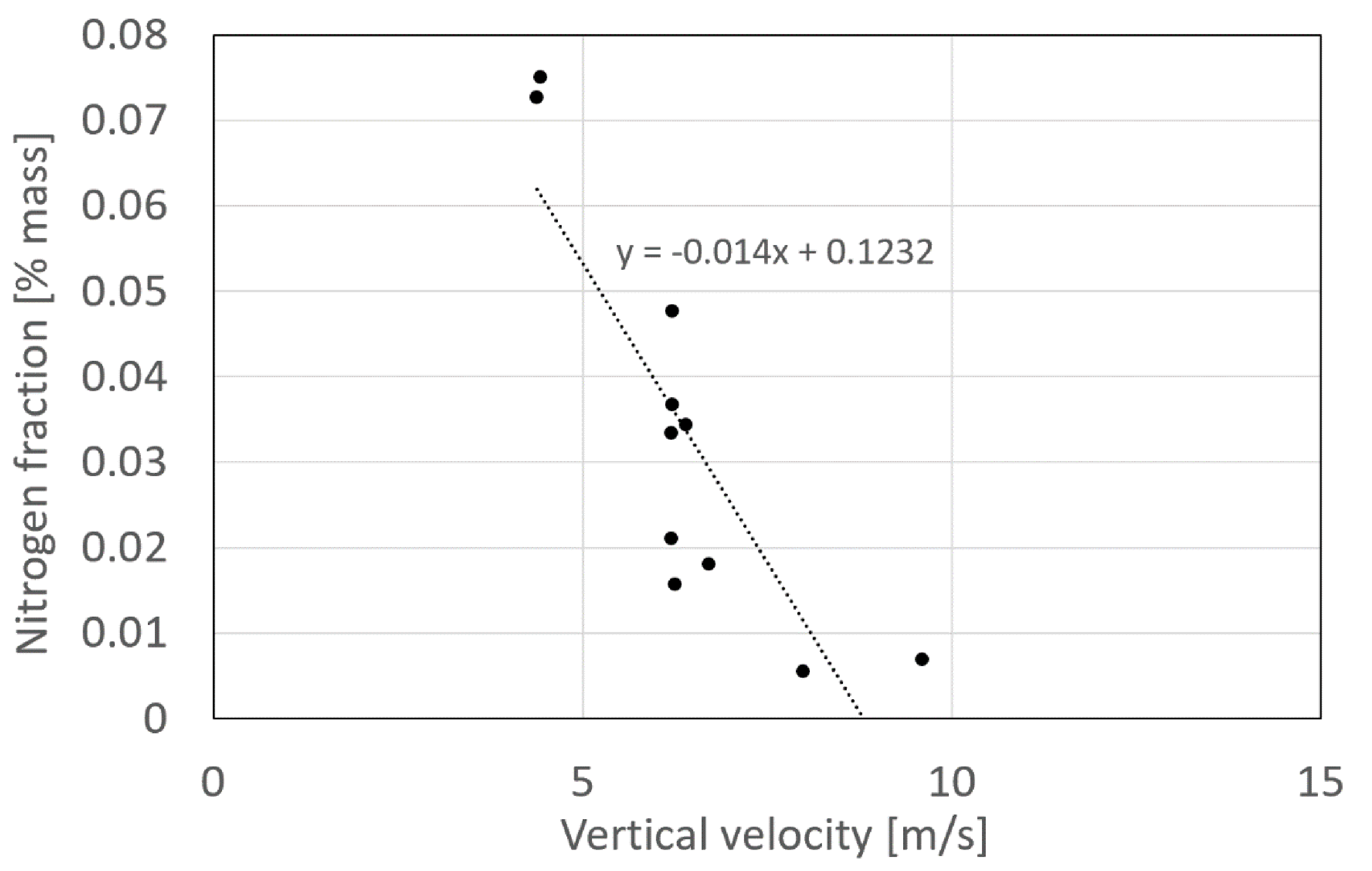
| Design Number | Nozzle Length (mm) | Nozzle Diameter (mm) | Orifice Number | Orifice Diameter (mm) | Remark |
|---|---|---|---|---|---|
| 1 | 47 | 16 | 2 × 8 | 2.0 | Standard |
| 2 | 58 | 16 | 2 × 8 | 2.0 | Influence of nozzle length |
| 3 | 36 | 16 | 2 × 8 | 2.0 | |
| 4 | 47 | 19 | 2 × 8 | 2.0 | Influence of nozzle diameter |
| 5 | 47 | 13 | 2 × 8 | 2.0 | |
| 6 | 47 | 16 | 1 × 8 | 2.0 | Influence of orifice number |
| 7 | 47 | 16 | 3 × 8 | 2.0 | |
| 8 | 47 | 16 | 2 × 8 | 1.5 | Influence of orifice diameter |
| 9 | 47 | 16 | 2 × 8 | 2.5 |
| Welding Parameters | Value |
|---|---|
| Camera | Memrecam Q1-V |
| Close-up lens | Micro-Nikkor 105mm 1:2.8 |
| Frame rate | 4000 fps |
| Aperture | f/5.6 |
| Exposure time | 51 μs |
| Filter | ND 4 + 640 nm |
| Welding Parameters | Value |
|---|---|
| Welding current | 280 A |
| Welding voltage | 30 V |
| Welding travel speed | 5 mm/s |
Publisher’s Note: MDPI stays neutral with regard to jurisdictional claims in published maps and institutional affiliations. |
© 2021 by the authors. Licensee MDPI, Basel, Switzerland. This article is an open access article distributed under the terms and conditions of the Creative Commons Attribution (CC BY) license (https://creativecommons.org/licenses/by/4.0/).
Share and Cite
Tashiro, S.; Trinh, N.Q.; Suga, T.; Matsuda, N.; Tsurumaru, N.; Maeda, T.; Tanaka, R.; Nakatsu, S.; Tsujii, G.; Bui, H.V.; et al. Influence of Cross-Wind on CO2 Arc Welding of Carbon Steel. Metals 2021, 11, 1677. https://doi.org/10.3390/met11111677
Tashiro S, Trinh NQ, Suga T, Matsuda N, Tsurumaru N, Maeda T, Tanaka R, Nakatsu S, Tsujii G, Bui HV, et al. Influence of Cross-Wind on CO2 Arc Welding of Carbon Steel. Metals. 2021; 11(11):1677. https://doi.org/10.3390/met11111677
Chicago/Turabian StyleTashiro, Shinichi, Ngoc Quang Trinh, Tetsuo Suga, Natsume Matsuda, Naotaka Tsurumaru, Tomohiko Maeda, Ryohei Tanaka, Satoshi Nakatsu, Gen Tsujii, Hanh Van Bui, and et al. 2021. "Influence of Cross-Wind on CO2 Arc Welding of Carbon Steel" Metals 11, no. 11: 1677. https://doi.org/10.3390/met11111677
APA StyleTashiro, S., Trinh, N. Q., Suga, T., Matsuda, N., Tsurumaru, N., Maeda, T., Tanaka, R., Nakatsu, S., Tsujii, G., Bui, H. V., & Tanaka, M. (2021). Influence of Cross-Wind on CO2 Arc Welding of Carbon Steel. Metals, 11(11), 1677. https://doi.org/10.3390/met11111677







